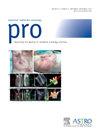Pictorial Guide to Delineating the Recurrent Laryngeal Nerve as an Organ at Risk.
IF 3.5
3区 医学
Q2 ONCOLOGY
引用次数: 0
Abstract
The recurrent laryngeal nerve (RLN) is especially vulnerable in cases of reirradiation, large-volume irradiation, or stereotactic body radiation therapy. Although RLN injury is rarely reported, it can cause hoarseness, swallowing difficulties, and airway obstruction, often with delayed onset. We aimed to map the course of bilateral RLNs on radiation therapy planning computed tomography scans to assess its feasibility as an organ at risk.
描绘喉返神经为危险器官的图示指南。
喉返神经(RLN)在再照射、大容量照射或SBRT的情况下尤其脆弱。虽然RLN损伤很少报道,但它可以引起声音嘶哑,吞咽困难和气道阻塞,通常有延迟发作。我们的目的是在放射治疗计划计算机断层扫描(RTP CT)上绘制双侧喉返神经的路线,以评估其作为危险器官(OAR)的可行性。
本文章由计算机程序翻译,如有差异,请以英文原文为准。
求助全文
约1分钟内获得全文
求助全文
来源期刊

Practical Radiation Oncology
Medicine-Radiology, Nuclear Medicine and Imaging
CiteScore
5.20
自引率
6.10%
发文量
177
审稿时长
34 days
期刊介绍:
The overarching mission of Practical Radiation Oncology is to improve the quality of radiation oncology practice. PRO''s purpose is to document the state of current practice, providing background for those in training and continuing education for practitioners, through discussion and illustration of new techniques, evaluation of current practices, and publication of case reports. PRO strives to provide its readers content that emphasizes knowledge "with a purpose." The content of PRO includes:
Original articles focusing on patient safety, quality measurement, or quality improvement initiatives
Original articles focusing on imaging, contouring, target delineation, simulation, treatment planning, immobilization, organ motion, and other practical issues
ASTRO guidelines, position papers, and consensus statements
Essays that highlight enriching personal experiences in caring for cancer patients and their families.
 求助内容:
求助内容: 应助结果提醒方式:
应助结果提醒方式:


